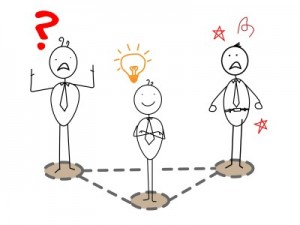LEADING COMMUNITY: Resolving Conflict
Description
Personal conflict can arise in any situation. As a changemaker, you nor your collaborators are immune just because your mission is to create positive impact. Whenever human beings are involved, personal conflict can arise. This activity is designed to help you explore the often uncomfortable yet normal scenarios that can crop up. To better equip you to deal with conflict as it arises, let the Thomas-Kilmann Conflict Mode Instrument (TKI) outlined below guide you.

Image Credit: www.interpersonalskillsonline.com
Let’s explore two scenarios where potential conflict can arise:
1) You ask a colleague to review a detailed report on the impact of your most recent community initiative. The report took you 20 hours to compile, draft, proof and polish. Your colleague glances at it for 5 minutes and then immediately rambles off a laundry list of everything you did wrong with the report. You feel frustrated and angry by the fact that he barely read the report and had only critical things to say about it. Now you simply wish to avoid working with him at all.
What strategy will you employ to address this issue?
2) As a new social venture, you and your key collaborators may not have enough resources to do the job. As a result, one of your fellow collaborators ends up carrying a heavy load, causing resentment towards others in the group who they feel may not be doing their share of the work. One day, this resentment builds up and the person ends up in an argument with one of the other venture collaborators.
How will you try and help your collaborators resolve the argument?
In order to address these two scenarios, let’s explore your style for conflict resolution. A commonly used tool to assess which style you tend towards when conflict arises is the Thomas-Kilmann Conflict Mode Instrument (TKI). This instrument identifies 5 main styles, as follows:
Competitive: People who tend towards a competitive style take a firm stand, and know what they want. They usually operate from a position of power, drawn from things like position, rank, expertise, or persuasive ability. This style can be useful when there is an emergency and a decision needs to be make fast; when the decision is unpopular; or when defending against someone who is trying to exploit the situation selfishly. However it can leave people feeling bruised, unsatisfied and resentful when used in less urgent situations.
Collaborative: People tending towards a collaborative style try to meet the needs of all people involved. These people can be highly assertive but unlike the competitor, they cooperate effectively and acknowledge that everyone is important. This style is useful when you need to bring together a variety of viewpoints to get the best solution; when there have been previous conflicts in the group; or when the situation is too important for a simple trade-off.
Compromising: People who prefer a compromising style try to find a solution that will at least partially satisfy everyone. Everyone is expected to give up something, and the compromiser him- or herself also expects to relinquish something. Compromise is useful when the cost of conflict is higher than the cost of losing ground, when equal strength opponents are at a standstill and when there is a deadline looming.
Accommodating: This style indicates a willingness to meet the needs of others at the expense of the person's own needs. The accommodator often knows when to give in to others, but can be persuaded to surrender a position even when it is not warranted. This person is not assertive but is highly cooperative. Accommodation is appropriate when the issues matter more to the other party, when peace is more valuable than winning, or when you want to be in a position to collect on this "favor" you gave. However people may not return favors, and overall this approach is unlikely to give the best outcomes.
Avoiding: People tending towards this style seek to evade the conflict entirely. This style is typified by delegating controversial decisions, accepting default decisions, and not wanting to hurt anyone's feelings. It can be appropriate when victory is impossible, when the controversy is trivial, or when someone else is in a better position to solve the problem. However in many situations this is a weak and ineffective approach to take.
By understanding these different styles, you can think about the most appropriate approach you would take for the two scenarios mentioned above. You would want to adopt an approach (or a mixture of approaches) that helps to resolves the issue at hand, respects peoples needs and interests, and words towards mending any damaged working relationships.
(Adapted from: http://www.mindtools.com/pages/article/newLDR_81.htm)
Task
1. After reviewing the description, write out a three-step plan to address each conflict scenario based on your identified style from the Thomas-Kilmann Conflict Mode Instrument (TKI).
2. Go to Discussions and post your plan for the corresponding scenario.
3. Respond to two other participants in the discussion thread – Would you have taken the same steps? Would you have done anything differently?
Learning Objectives
Through this exercise, you will learn about how to resolve conflicts that can arise amongst project stakeholders in a new social venture. You will explore two examples of potential conflicts, and how to understand your style of conflict resolution through the review and application of the Thomas-Kilmann Conflict Mode Instrument (TKI). Featured skills and competencies include: risk management, oral communication skills, relationship building and problem solving.
Continue to LEADING OTHERS: Building a Dream Team »
Submissions (4)
-
Gregory Discussion post: 4239.2 days ago
-
Faricka Merrick Discussion post: 9512 days ago
-
Faricka Merrick Discussion post: 9512 days ago
-
Faricka Merrick Discussion post: 9512 days ago
